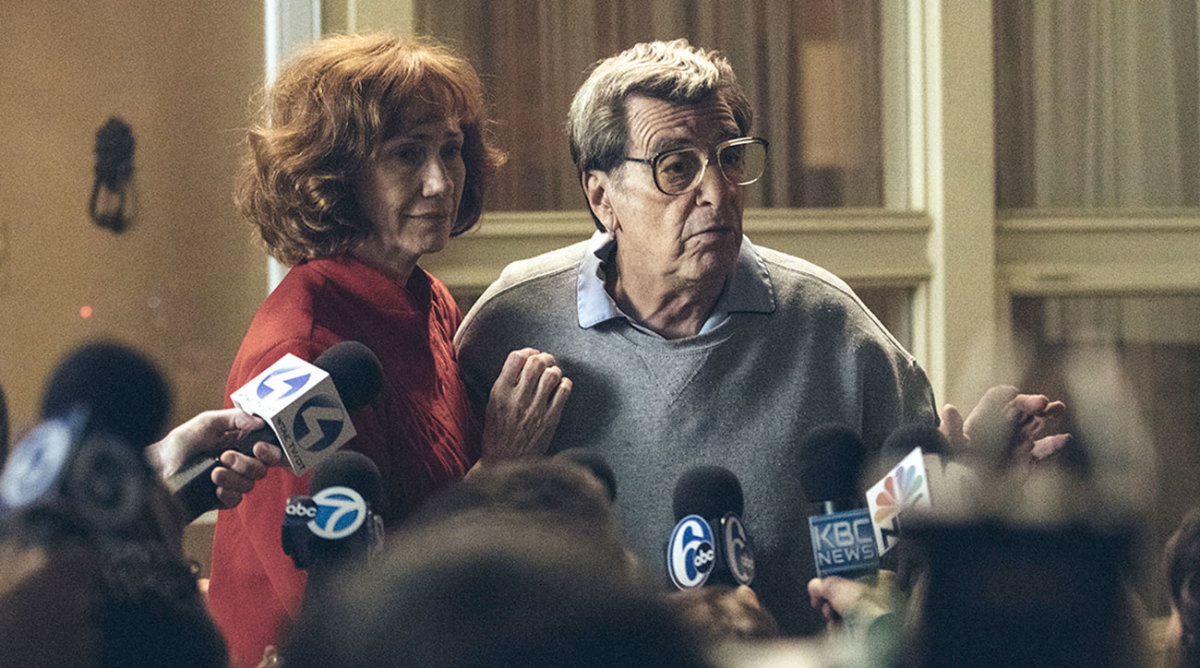“Paterno” Fails to Get to the Heart of the Penn State Scandal

There is a line about an hour and 30 minutes into HBO’s Paterno when someone asks Patriot News reporter Sarah Ganim’s character an important question: “A crime against children happened. Why are we talking about Joe Paterno?”
Throughout the film I found myself wanting to rewind and physically clock the amount of time director Barry Levinson spent covering the indescribable pain and agony felt by the victims of Jerry Sandusky. To me, it felt like subplot—a line of context forced into a sweeping narrative about a man wrestling with his past and present. Hence, the name Paterno.
Maybe, as one reviewer in The Guardian suggested, no one would watch a movie about a blinding daily struggle, a crime so personal and cruel, because, as some victims testified, they are still confronted by the horror on a daily basis.
We tend to gravitate this way with difficult subject matter. As the economy crashed, we flocked to a motion picture about the swaggering investors who broke the system and not the devastated families whose lives turned to financial ash. When child abuse in the Catholic Church was exposed by the Boston Globe, we wanted to watch the reporters who uncovered the truth.
There are moments during Paterno where the viewer is forced to play ball. Al Pacino is talented enough to convey the emotional weight Paterno must have felt toward the end of his life. You think, if he was innocent in all of this, what an awful way to die. The movie puts you in a place—Paterno’s Brady Bunch home, nestled in a beautiful, quiet neighborhood—about which America wondered endlessly during the winter of 2011.
This is where, I feel, Levinson wanted us to linger. But why?
Most of us hate ambiguity. Movies are supposed to be a break from the impossibility of real life. In real life, we are heroic and awful on an every day basis. We are brave and we are scared. We are good husbands and wives, and we are petty, insensitive malcontents.
In that way, we will wrestle with Paterno because it never truly takes a side and tries to paint Penn State’s legendary coach as a realistically flawed man. One moment, he is still a the emperor; someone sage enough to call game-winning plays off sheets of paper in the coach’s booth and shrewd enough to notice sideline photographers taking his picture when they’re not supposed to—a Godfather obviously able to use his age as a tool to hide from his role in the tragedy. Then we are placed in his 1950s-style living room. He wears ill-fitting pajamas, hobbles around like an old retriever and watches the news coverage of the most heinous collegiate athletic scandal in American history as if he’s being hit with a tidal wave. He is the lovable football hermit—too wholesome, too focused on the Nebraska game, to understand the evil festering around him.
The two moments that actually drill into Paterno’s true character are both cliffhangers—once midway through the film, when Paterno’s daughter asks him if he inquired about the child Mike McQueary told him was being abused by Sandusky in the shower, and again at the end of the film when Ganim takes a call from the person later known as John Doe 150, who alleged that he told Paterno about being sexually abused by Sandusky in 1976, and Paterno told him he didn’t want to hear about it.
This, too, is a popular vehicle for movies. Let the viewer decide. Everyone has his own filter, and the truth is unique.
I wonder, though, if this was a situation that deserved such haziness. It’s troubling that, years later, we’re still left playing tennis against a brick wall when it comes to our thoughts on Penn State and Joe Paterno.
What a sweet old man; a grandfather after our own heart; someone endlessly devoted to the game he loved.
How could a person build a career on the development of young men but seemingly care so little about young lives being destroyed by one of his closest allies?
As a film, Paterno is fine. Conceptually, it’s a step above the recent trend of dramatizing seminal moments in recent American history, like the flurry of O.J. Simpson specials last year.
But like the people who gawked at the Simpson series without pondering the real issues of race, power and sexism, I fear there will be those who just see Paterno as another book on the “Remember When?” shelf. There were riots on campus from otherwise reasonable, free-thinking students. There were adults with young children who made this an argument about wins and losses.
If there is some good to come from Pacino’s performance, it is in the moments when he confronts his recollections of Sandusky, alone inside an MRI machine—moments where he presumably wasn’t too sidetracked or focused to see what the monster in his office was doing. It’s not enough and will never be enough, but if we’re to allow our imaginations to wander, it’s nice to believe that there was a thousand-ton burden on Paterno’s mind through the end.
Maybe the next Hollywood entry in the Penn State story will pick apart the less famous people, those who’ve been proven to be culpable, with similar artistry. We can go through them all, from Sandusky, to his charity officials, to child welfare workers, to university leaders. That would place the focus where it should be, on the victims who are actually at the heart of the story.
Question or comment? Email us at talkback@themmqb.com.





































